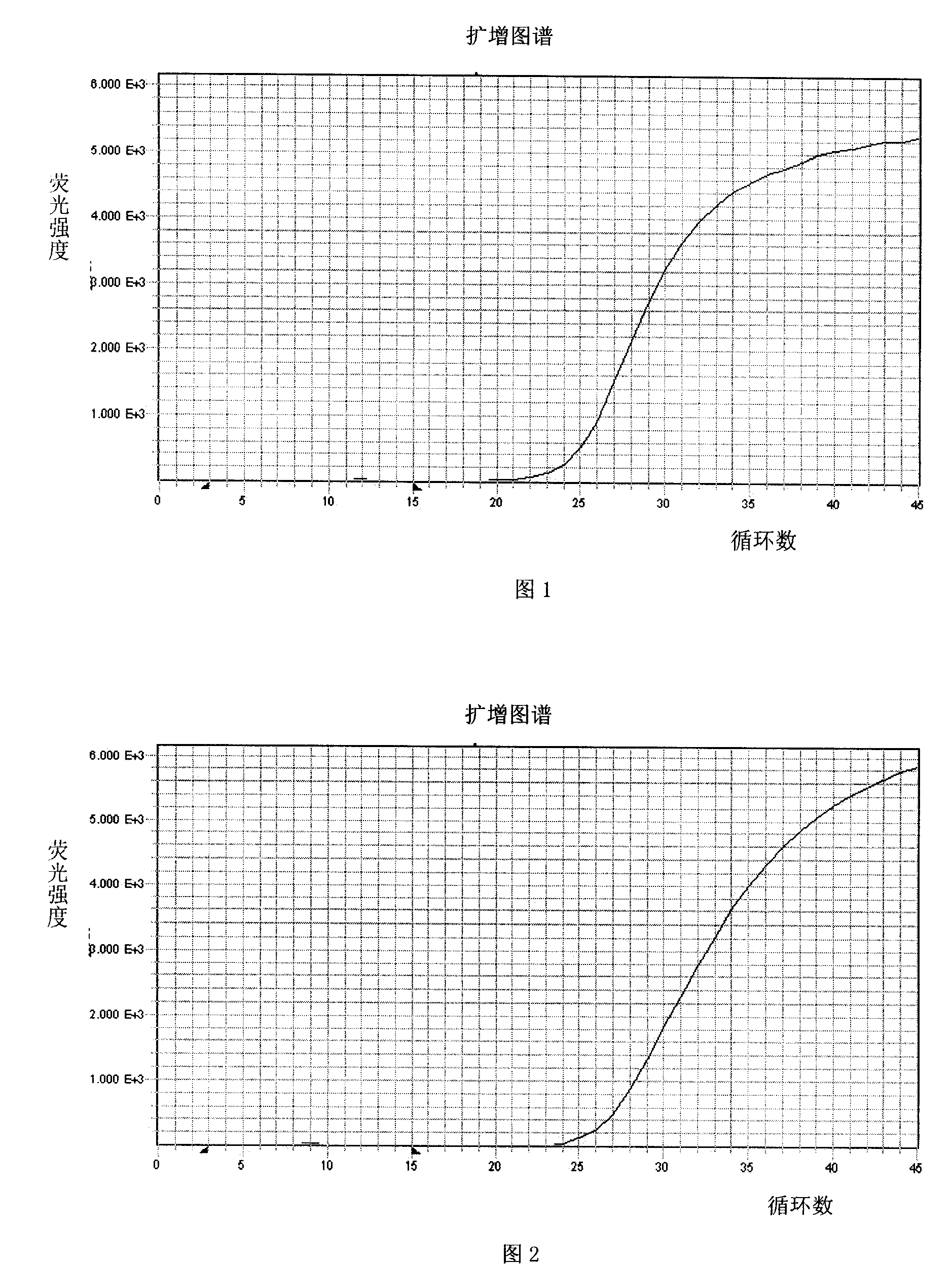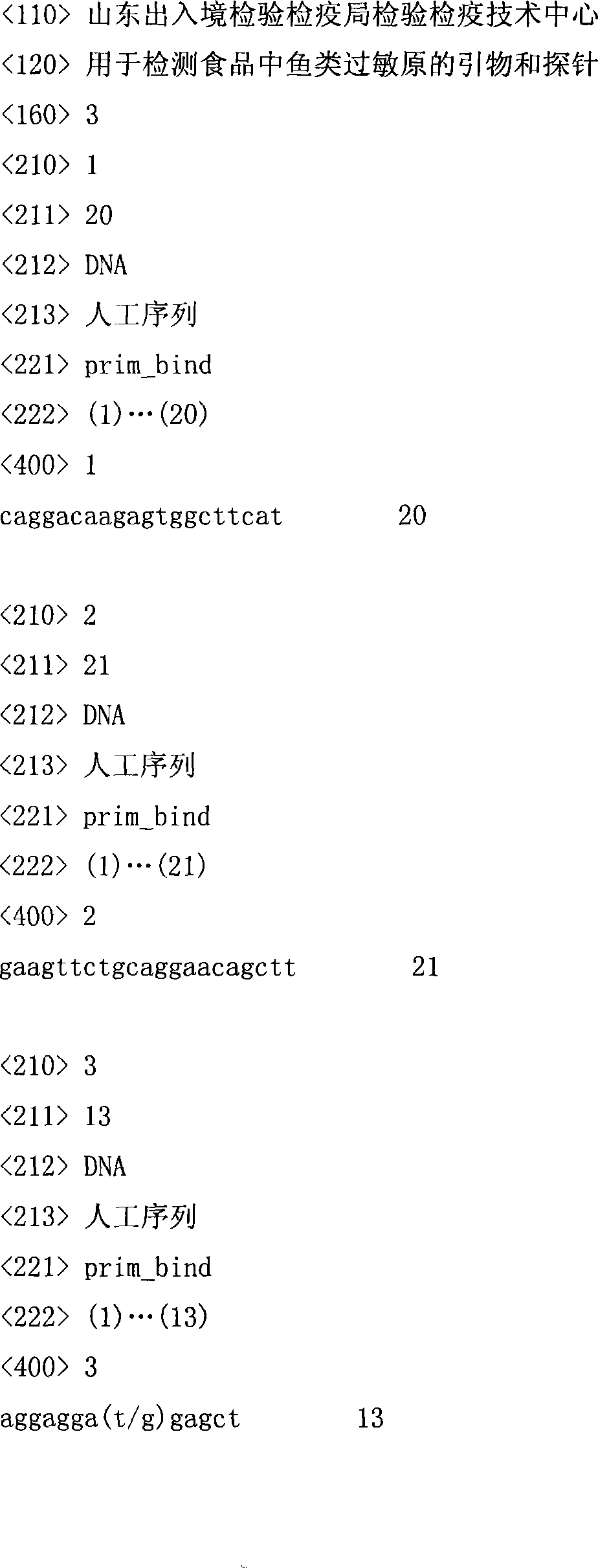Primer and probe for detecting fish anaphylactogen in food
An allergen and fish technology, applied in biochemical equipment and methods, microbial determination/inspection, DNA/RNA fragments, etc., can solve problems such as high price and limited fish species to be detected
- Summary
- Abstract
- Description
- Claims
- Application Information
AI Technical Summary
Problems solved by technology
Method used
Image
Examples
Embodiment 1
[0032] Follow the procedure below for testing:
[0033] (1) Extraction of DNA from fish ball samples to be tested
[0034] A. Weigh 0.5g fish balls, cut them into pieces, and transfer them to a 1.5mL centrifuge tube. Add 500 μL extraction buffer lysate (0.05M Tris-HCL (trishydroxymethylaminomethane-hydrochloric acid), 0.1M EDTA (ethylenediaminetetraacetic acid), 0.2M sodium chloride, pH 7.6 sterilized double distilled water) , full oscillation;
[0035] B. Add 60 μL of proteinase K and 2 μL of 10% SDS, mix by inversion. Water bath at 57°C for 10 hours until the raw material is digested into a clear liquid, centrifuged at 4000 rpm for 2 minutes, and the supernatant is taken;
[0036] C. Add 500 μL equal volume of Tris-phenol, mix by inversion for 10 minutes, centrifuge at 12000 rpm for 10 minutes, and take the supernatant;
[0037] D. Repeat the previous step;
[0038] E. Add Tris-phenol, chloroform and isoamyl alcohol (volume ratio is 25:24:1) to the supernatant, mix it u...
Embodiment 2
[0053] Follow the procedure below for testing:
[0054] (1) Extraction of DNA from fish floss samples to be tested
[0055] A. Weigh 0.5g fish floss, cut it into pieces, and transfer it to a 1.5mL centrifuge tube. Add 500 μL extraction buffer lysate (0.05M Tris-HCL (trishydroxymethylaminomethane-hydrochloric acid), 0.1M EDTA (ethylenediaminetetraacetic acid), 0.2M sodium chloride, pH 7.6 sterile double distilled water) , full oscillation;
[0056] B. Add 60 μL of proteinase K and 2 μL of 10% SDS, mix by inversion. Water bath at 57°C for 10 hours until the raw material is digested into a clear liquid, centrifuged at 4000 rpm for 2 minutes, and the supernatant is taken;
[0057] C. Add 500 μL equal volume of Tris-phenol, mix by inversion for 10 minutes, centrifuge at 12000 rpm for 10 minutes, and take the supernatant;
[0058] D. Repeat the previous step;
[0059] E. Add Tris-phenol, chloroform and isoamyl alcohol (volume ratio is 25:24:1) to the supernatant, mix it upside ...
PUM
 Login to View More
Login to View More Abstract
Description
Claims
Application Information
 Login to View More
Login to View More - R&D
- Intellectual Property
- Life Sciences
- Materials
- Tech Scout
- Unparalleled Data Quality
- Higher Quality Content
- 60% Fewer Hallucinations
Browse by: Latest US Patents, China's latest patents, Technical Efficacy Thesaurus, Application Domain, Technology Topic, Popular Technical Reports.
© 2025 PatSnap. All rights reserved.Legal|Privacy policy|Modern Slavery Act Transparency Statement|Sitemap|About US| Contact US: help@patsnap.com


